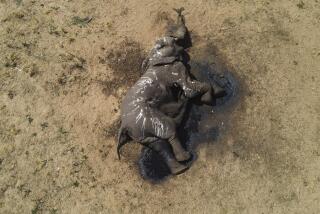Wildlife Problems : In Kenya, It’s Man Versus Animal in Battle for Space
NAIROBI, Kenya — Though a delight for tourists, Kenya’s heavily protected wildlife is a frequent source of frustration and anguish for rural people competing with the animals for living space.
Farmers often spend their nights tending bonfires and beating drums or garbage can lids to frighten elephant herds away from crops. Wildlife authorities build moats and put up electrified fences to keep animals in designated reserves.
And crops aren’t the only victims. Almost weekly, Kenyan newspapers report attacks on humans, many of them fatal, by lions, buffalo, crocodiles, hyenas and other beasts.
At one point in 1982, officials dealt with the problems posed by crop-ravaging baboons and man-eating crocodiles by shooting the baboons and feeding them to the crocodiles.
Population Boom
Kenya’s population of 20 million people is increasing at around 4% annually, the highest growth rate in the world, and there are intense demands for the 15% of the land suitable for crops.
But wildlife also is proliferating, thanks to a 1977 ban on hunting, and the result is often a head-on collision as contacts between animals and people multiply.
William Nzeki, a farmer from the Machakos district east of Nairobi, told the Daily Nation newspaper of Nairobi that elephants just recently destroyed the equivalent of $4,000 worth of corn, peas and sweet potatoes.
“They come for dinner and nobody can scare them away,” the paper quoted him as saying. “We don’t know what to do, because nobody is authorized to kill them.”
Scare Tactics
Nzeki said game wardens try to scare away the elephants with explosives, but the animals reappear soon afterward, the paper reported.
The government runs a massive compensation program that has paid farmers millions of dollars for crop damage in the last 10 years, but many farmers complain that the reimbursement process is time-consuming and complicated.
“The government should pay close attention to this, because the future of wildlife depends on the appreciation of local people,” said Nehemiah Rotich, executive director of the East African Wildlife Society. “If the people don’t appreciate the animals, they won’t be prepared to work with the authorities to preserve them.”
The government is trying to strengthen public support for wildlife conservation through a program that includes filmstrips in schools, posters urging protection of endangered species, and appeals for support in combatting poaching.
Domestic Tourism Promoted
J.P. Oriero, deputy director of the Wildlife Conservation and Management Department, said one promising strategy is to encourage more Kenyans to visit game parks. This is part of a broader campaign to promote domestic tourism, and the government is urging hotel owners to provide discounts to Kenyans.
Rotich said the government should think of ways to make rural Kenyans who compete directly with wild animals feel that they are directly benefiting from tourism revenues.
Tourism is Kenya’s third-largest foreign currency earner after coffee and tea, and it was the decisive factor in the 1977 ban on hunting. Since the ban, the population of virtually every game species has increased except for the rhinoceros, a favorite target of poachers who find a lucrative illegal market for its horn.
No Change in Policy
Some conservationists have advised the government to allow limited hunting or to implement programs to pare herds that appear to be growing too large. But the government says no major changes in its policies are under serious consideration.
Kenya has 40 game parks and reserves covering about 10% of its land area, which is slightly smaller than Texas. Oriero said major expansion of the existing parks network is unlikely unless local officials take the initiative in proposing parks in their areas.
“We must be realistic in recognizing other demands on the land,” said D.N. Sindiyo, director of the wildlife department.
‘Happy With What We Have’
“We’re quite happy with what we have. We don’t want to generate hostility just by grabbing more.”
Oriero predicted that over the next few decades fewer and fewer wild animals will be found outside the parks and reserves as human pressure intensifies and more land for livestock grazing is needed.
More to Read
Sign up for Essential California
The most important California stories and recommendations in your inbox every morning.
You may occasionally receive promotional content from the Los Angeles Times.










